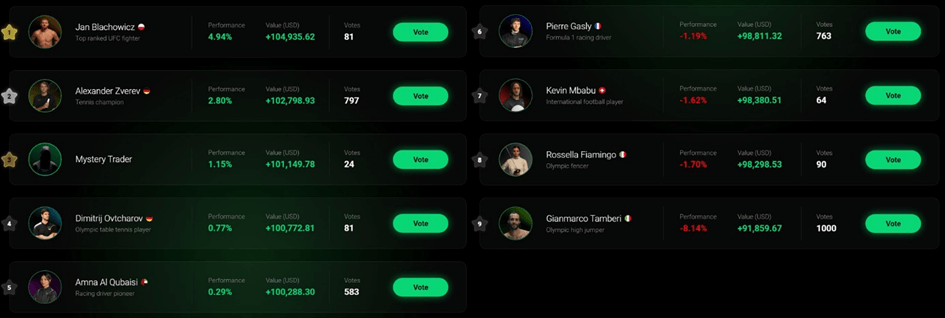The FlowBank Championship is in full swing: with the help of educational content and tools like technical analysis, the nine athletes try to find the best trades. Learn how technical analysis works and what conclusions can be drawn from it, using Nvidia's stock price as an example.
The first week of the FlowBank Championship is already over. After everyone started with a virtual capital of 100,000 USD, there is now almost 15,000 USD between first place Jan Blachowicz, Polish UFC fighter, and Gianmarco Tamberi, Italian high jumper, who is currently in last place. However, nothing is decided yet - the FlowBank Championship will continue until June 10, 2023. The rankings are constantly updated and can be accessed here.

Status: 19.05.2023
Analyses of the various trades made by the nine athletes in the first week of the online trading championship provide a fascinating insight into their strategy. Several followed the news cycle and derived trading ideas from it. With artificial intelligence currently being covered in the media from all angles, several of the athletes bet on tech stocks with a connection to artificial intelligence (AI). These include Alphabet (GOOGL) and C3.ai (AI), among others. Alphabet's shares rose, then, following the announcement that AI will be built into Google's search engine in the future.
In addition, participants are largely taking a cautious approach and diversifying their portfolios. Instead of attaching great weight to individual positions, they divide their trades among several stocks and ETFs.
Nevertheless, some also take on more risk: individual sports stars also use CFDs and leverage their trades with them. By doing so, they hope to win the FlowBank Championship - but of course they also risk incurring significant losses.
More informed decisions thanks to technical analysis
In addition, the athletes also resort to technical analysis. This method allows securities to be evaluated on the basis of statistical trends and historical data. With the help of charts and other indicators, patterns and trends can be identified, allowing potentially profitable investment opportunities to be identified early on and risks to be minimized.
One popular technical indicator is moving averages. These are calculated by averaging the price of a stock over a period of time. The result is a smooth line that can be used to identify the overall trend of a particular stock price. The noise of daily price movements is thus filtered out. A simple moving average is calculated by adding up the closing prices of a stock over a given time period and dividing by the number of time periods.
Support and resistance are two key concepts in technical analysis that can help identify potential entry and exit points. Support is a price level at which a stock has attracted buying interest in the past and tends to climb higher. Resistance, on the other hand, is a price level where a stock has encountered selling pressure in the past and tends to fall.
However, it is important to note that both support and resistance levels do not last forever, but will eventually be broken again.
Nvidia has momentum
To illustrate the point, Nvidia stock (NVDA) has been attracting a lot of attention lately. The company is among the leading manufacturers of graphics processors, producing a critical component of many AI applications, including ChatGPT.

Source: FlowBank, TradingView
NVDA is in a strong uptrend, with the 50-day moving average serving as strong support. Investors can consider buying if the share price bounces off this level, or simply maintain a bullish bias as long as the price holds above the moving average.
The share price broke out of long-term resistance at 190 earlier this year, triggering the current uptrend. A short-term support level is at 260 and a resistance level is at 280. The holding of the 260 support level and the break of 280 suggest that the price could climb higher in the future.




